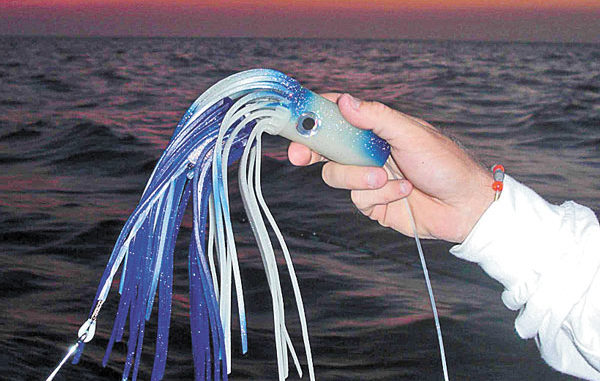
Not everyone wants to spend the night on the ocean fishing for swordfish. It is a discipline that requires special tackle, glow-in-the-dark lures and a confident captain.
Each summer, Capt. Pete Loy of the Lil’ Bit guides his crew into the Atlantic Ocean on an overnight quest for swordfish and sea-going adventure.
Leaving the dock at 1 p.m. for an offshore trip is quite a change from the normal 4 a.m. departure time for a day-trip. With the galley packed with enough rations for several days — because no one wants to come up “short” on food and water — the 50-foot boat eased out of Hobcaw Creek before navigating Charleston Harbor.
A weather forecast for diminishing seas overnight is preferred, and extended forecasts are always consulted. After about a 90-minute ride and a few calls on the radio, a resourceful captain can find the spot where the day’s best fishing action of the day has occurred. The swordfish bite doesn’t start until nightfall, which leaves several hours to try and raise a sailfish.
Fish “dink” baits set out at various lengths behind the boat and troll at 4½ knots. The view from the cockpit affords the best angle to see a bill breaking the surface. “Sailfish!” yells first-mate Coy Johnson, who drops the bait back a bit farther — but no hook-up.
The charter fleet heads back to port late in the afternoon, and it becomes apparent that solitude will accompany the darkness of night. Still, the last few hours of the day can be very productive for offshore fishing, and they seldom get fished.
An hour before sundown Lil’Bit makes a run to deeper waters, those favored by swordfish. Stopping in 1,200 feet of water about 70 miles out of Charleston, special lures are rigged up with glow-stick inserts, and special teasers with glowing contents are rigged up.
Whole squid from the bait freezer are attached to the hooks, but fishermen are also hopeful to catch fresh squid during the night. Besides the beauty of the setting sun over the ocean, everyone can witness “nature’s fireworks” as the afternoon thunderstorms continue firing off after dark.
Lights shining into the water from the transom begin to attract flying fish in decent numbers, but whether to keep lights on at night or to simulate “blackout” is a subject greatly debated among swordfish anglers. The same can be said about leaving on the generator to run air-conditioning and such, or whether to switch everything off and imitate “dead” water.
Swordfish are a good example of sustainable seafood, and they are welcomed as responsible menu items in fine restaurants, although Loy said, “We don’t keep any swordfish, because these trips are more about the camaraderie and fellowship on the deep blue sea.”
Loy uses a 3-line spread at night and mainly drift fishes, after turning up the gain on his depthfinder to better see the thermoclines he wants to target. All the baits are rigged with a squid on an offset circle hook and a blinking lure, attached to a black mono leader and 400-pound test line. A 12-ounce bank sinker is attached to the rig with a rubber band — it’s designed to break free during a fight. The first line is fished 50 feet deep, the next 250 feet deep and the last is 400 feet deep — with all lines attached via rubberband to a milk jug filled with glow sticks.
Plan swordfish trips just ahead of and in sync with a full moon for best results. One can expect fairly steady action from nocturnal predators like hammerhead and mako sharks. An angler needs the right gear for swordfishing, and www.PelagicGear.com makes clothes specifically for the offshore angler, including fighting gloves and their “hurricane jacket,” which keeps anglers dry and warm overnight.
Trolling for swords is not unheard of, and Loy’s bullet points for covering ground are to troll at six knots downsea if possible, monitor for bait concentrations, bring the boat in and out of gear for maximum bait presentation, dress the hooks with a strip bait, turn on your underwater lights and set the outrigger release pins very light.
If no swordfish appear by the time dawn breaks, a small concession is that the sportfisher is already in prime position for offshore trolling. Loy likes to deploy a full spread of plugs to fast-troll for wahoo, and fate has brought him some early-bird wahoo that can make the entire crew proud.
As the charter fleet returns to the fishing grounds, the radio crackles with life because a hot sailfish bite is news worth sharing. Loy turns the Lil’ Bit back towards shore and the sailfish action. It won’t be hard to spot a gathering of sportfishers.
Releasing a sailfish or a swordfish may not be quite as thrilling as releasing a white marlin or a large blue marlin, but the fact that the Super Slam exists out there is enough to keep offshore enthusiasts spending plenty of sleepless nights on the Atlantic.



Be the first to comment